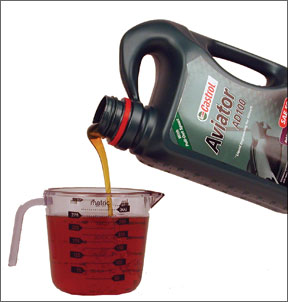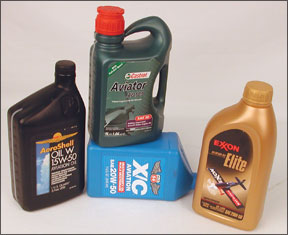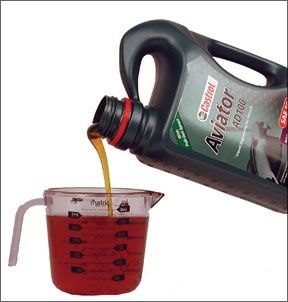When an engine tanks prematurely, the recriminations begin. Did the shop screw up the overhaul? Was it bad cylinders? Or could it have been the oil you used? Yeah, maybe thats it…if only youd used Exxon Elite instead of Aeroshell, you wouldnt be looking at a mid-time overhaul. This is the sort of fear, uncertainty and doubt that advertising is meant to mine. And the copywriters are good at it. Elite, for instance, is touted as offering a two-fold increase in rust protection over the nearest competitor. Aeroshells popular 15W50 “helps engines start faster and eliminates need for seasonal oil changes.” BP is marketing Castrols aviation oil and not just claiming its the best, but offering to prove it with lab tests showing Castrol Aviator passed rust and engine deposit trials while its competitors failed. Whats going on here? Are the oil companies lying or just stretching the truth? In our view, its more the latter than the former-the engine oil ads make claims that are demonstrably true, but they make no effort to place these claims in context. The oil companies are happy having you make buying decisions in their favor with little grasp of the larger picture of oil performance. The reality is that aircraft engine operation is so fraught with variables that bench testing of oils illuminates only a shred of what you need to know to make an informed choice. The real meat of the matter derives from meaningful and in-depth data on field performance and this is almost impossible to come by. So if bench testing is of such limited use, why do it, as we did-expensively-for this article? Bench tests do allow comparisons of oil under controlled conditions which cant be duplicated in the field. All lubricating oils are expected to meet certain core performance requirements with regard to chemical composition, lubricity, viscosity, pour points and so on. Bench tests are the starting place to see which oil does what best. Second, corrosion protection is an increasingly important aspect of aircraft engine performance because airplanes don’t fly as much as they once did. Measuring how we’ll an oil protects against rust is still an imprecise science, but the lab analog for rust protection is more reliable than the analog for anti-wear protection, in our view. For this article, we set out to examine BPs claims and place them in the context of the larger issue of oil selection. Further, we compared our current first-choice oil, Phillips XC additized with CamGuard, to see if there’s reason to switch. Contenders If there’s such a thing as a big three in engine aircraft oils, its Aeroshell 15W50, Phillips XC and Exxon Elite, more or less in that order by market share, although Exxon may have edged Phillips by now. Since about the mid-1990s, BP has marketed Castrols Aviator products in Europe and elsewhere, but only recently has it made a run at the U.S. market with promotional campaigns. There are fundamental differences in the way these four companies approach the engine oil market. Phillips makes a line of monograde and multi-grade oils all based on mineral basestock-it doesnt use any blended synthetics, nor does it additize the oils. XC is a relatively simple, non-additized multi-grade mineral oil. If your engine requires Lycoming additive (LYC LW16702), you have to add it to the sump on your own. Both Aeroshell 15W50 and Exxon Elite are blended synthetics, consisting of a mixture of mineral oil and polyalphaolefin. PAO basestock was developed during and after World War II as a means of improving mineral oil performance in the turbocharged radials of the day. PAO has good low temperature performance and resists oxidation, but it has poor solvent characteristics, so its less good at dissolving combustion byproducts, which is why PAO oils are mixed with mineral oil. Aeroshell and Exxon have sophisticated additive packages and both meet the requirements of Lycoming LW16702, an anti-scuff compound. While the big three offer both multi-grade and monograde oils-some with additive packages, some without-BP/Castrol has pursued a strategy of offering mainly monogrades in up to four weights-65,80,100 and 120. The product we tested was Castrols AD 100, which, like Phillips XC, is a pure mineral oil product but with a full additive package, including compliance with Lycoming LW16702. Although most owners don’t think about it, there are substantial differences in prices between these oils. At $4.40 per quart (discount), Phillips XC is the least expensive, followed by Castrol Aviator at $5.90, Exxon Elite at $6.50 and Aeroshell 15W50 at $6.95. High to low, thats nearly a 60 percent price difference which, presumably, owes to the additive package and the PAO blending. But is the price Delta worth it? Our analysis follows.
Testing
The charts on page 5 summarize the test results and the sidebar on page 8 explains how the tests work. We hired Petro-Lubricant Testing Laboratories in Lafayette, New Jersey, to perform the trials. The labs director, Joe Wintermute, suggested two standard tests: the four-ball wear test and the Falex pin and v-block test. Although oil can be subjected to wide variety of bench testing, we agreed that these tests would give us the best general snapshot of the oils.
In addition, we conducted our own anti-corrosion tests which are summarized below. While the wear and pressure tests might not be definitive, we think the corrosion trials were and were comfortable making our recommendations using this data.
Four oils were tested: Phillips XC additized with CamGuard, Exxon Elite, Aeroshell 15W50 and Castrols Aviator 100AD. Reviewing the test results with Petro-Lubricants Wintermute, we believe the test data shows that all of the oils perform similarly. Among the four, there was no slam dunk standout, nor was there any meaningful poor performer. In the four-ball test, Exxons Elite did slightly better, with an even coefficient of friction and the smallest wear scar of any of the

samples. But the difference was slight enough to consider all of the oils as being in the same performance class.
The v-block trial, which tests the oil film across a broader bearing area-such as a gear contact surface-revealed similar performance results. The numbers do vary somewhat, but not over a range that Wintermute believed to be significant.
Hold the Phone
We passed these results by the oil and additive manufacturers for their comments and, not surprisingly, this vividly illustrated the notion that bench tests can be interpreted in starkly different ways.
Ed Kollin, who developed CamGuard, challenged the tests because they were conducted at a higher loading than are typically found in an aircraft engine. Both he and Wintermute pointed out that various additives react differently depending on the pressures and temperatures theyre subjected to. Kollin told us a better measure of oils is to conduct the tests at lower loads and to perform the v-block without step loading.
On the other hand, BPs Matt Mason told us our tests yielded the results he would have expected to see, but, in contrast to Kollin, he would have specified higher loads for the tests. He also concedes that to adequately evaluate an oil, bench tests should be read in conjunction with field experience, including wear metal analysis.
“When you have data like this, its open to interpretation. If I pull samples from 100 aircraft, you don’t know all the variables…what the leaning was, how the engine was run, how often. There are so many variables that its hard to draw a conclusion,” Mason told us.
This raises a critical point: field analysis of engine oils. We know that manufacturers do this, but because the data is proprietary, we don’t know how extensive their field work is and, more important, were not privy to the results. Mason told us BP has a considerable body of field test data, but concedes its “not monstrous.”
Our Analysis
The more we test and analyze aircraft engine oils, the more we conclude that unless an engine is subjected to unusual operating profiles, all of these oils will perform similarly. If you fly frequently, lean aggressively and change your oil often, we doubt that a side-by-side wear metal analysis will reveal meaningfully different results between these oils, even though the tests reveal subtle differences. But there is one important difference that could prove definitive in the life of an engine: corrosion prevention.
The operational outlier here is “fly frequently.” Because of fuel prices, many of us don’t fly much, so engines may rest idle for many weeks, if not months. In the dry desert, this might not be a worry, but in a coastal area or the humid Midwest and Northeast, it could be disastrous. Our tests show that all of these oils produce a film that will protect against corrosion for 14 to 30 days, but beyond that, some polished parts-cam and lifter surfaces and cylinder bores-may be subject to pitting. If its deep enough, pitting can lead to spalling, which can trash cams and lifters in short order.
So we think corrosion protection performance should be at the top of the list in selecting an engine oil. In that context, we conclude that its a mistake to use any oil that doesnt have a specific anti-corrosion additive, unless the engine is flown often, which we would define as at least once a week to full operating temperature.
Of the oils tested here, only one, Phillips XC, has no anti-corrosion additives. But there are others on the market, including Shells monograde W100 and mineral oils and BP/Castrols Aviator S products, which are suitable as unadditized break-in oils.
CamGuards Ed Kollin believes that if we had run our tests at lower loads, the CamGuard/Phillips XC combination would have performed markedly better and that his field tests indicate CamGuard yields a 35 percent reduction in wear metals. While this may be true, wear metal levels in a conforming engine thats properly operated are low to begin with, so improving them by 35 percent, while desirable, isn’t a game changer. Were skeptical that it would make a measurable difference over the life of the engine.
For its oils, BP publishes test results touting superior corrosion protection and anti-oxidation and anti-deposit qualities, but it doesnt seem to be pushing anti-wear qualities. Again, we think the BP/Castrol products perform on par with the other oils tested. While deposit formation is a concern in engines, our view is that its less of a worry than corrosion in an engine thats infrequently flown. Further, if the engine is leaned aggressively-and in the era of $5 avgas, thats a given-fewer combustion byproducts will find their way into the oil.
Recommendations
As weve revealed here, oil bench tests can be designed and interpreted to cast a product in only the warmest golden glow. After all, how could a guy in a white lab coat mislead you? With this in mind, read the ads with vigorous skepticism.
Based on our findings, picking an oil is not so much making the right choice as avoiding the wrong one. And in our view, the wrong choice is an oil without an anti-corrosion package. For infrequently flown engines, the risk of disastrous corrosion is too high and the solution is too cheap and effective to ignore.
Our first pick of oils, than, is Phillips XC additized with CamGuard. Because its a mineral basestock, its a better contaminant solvent then the blended synthetics and its relatively inexpensive. Adding CamGuard to it raises the per-quart price by $2.50, making it about a nickel cheaper than Aeroshell 15W50. But because its anti-corrosion performance is superior to any of the oils, its easily the overall best performer and best value.
How about adding CamGuard to any of the other oils? Thats an option and it will improve corrosion protection without diminishing the oils other positive characteristics, at least according to CamGuards Kollin. It will, of course, add $20 to every oil change.
How about semi-synthetic versus mineral? And monograde versus multi-grade? We tilt toward the mineral basestocks because of their superior solvent characteristics. Aircraft engines are riddled with blowby and the oil has to dissolve and carry away a heavy load of combustion byproducts.
We think mineral basestocks do that better. However, PAO blended oils retain their characteristics longer than mineral oils; mineral oils tend to degrade gracefully. But when PAO oils do degrade, there’s nothing graceful about it. But if the oil is changed frequently, as it should be, we don’t think this is important. Of the two semi-synthetics, we would pick Exxon Elite over Aeroshell because it contains less synthetic base-25 percent versus 50 percent for Aeroshell. If youre a big believer in synthetics, go with the Aeroshell.
Last, monograde versus multi-grade. Although weve heard claims that monogrades offer better corrosion protection than multi-grades because theyre “stickier,” our tests have repeatedly disproved this. The oft-cited evidence is the “dipstick test.” An hour after shutdown, the dipstick will retain a healthier dose of a monograde than it will a multi-grade. This may be true, but its the additive package that does the anti-corrosion heavy lifting, not the film itself. A heavy film of the wrong oil can easily contain corrosive elements that an anti-corrosion additive will defeat.
If you live in a climate where seasonal oil changes arent necessary, a monograde may make sense. Otherwise, the multi-grades-Phillips XC, Exxon Elite and Aeroshell 15W50-will perform just as well, without having to hassle the seasonal switchover or carry different types of oil in your baggage compartment.
Finally, where does BPs Castrol Aviator fit in? We think its a perfectly competent oil, with good anti-wear, anti-oxidant and anti-corrosion properties. But, in our view, its not such a standout compared to any of the other oils, so we cant make a strong case for or against it. If you prefer monograde mineral oils, the Castrol Aviator AD line-an additized oil-is probably as good a choice as any. BPs Matt Mason told us the company is devising some new test protocols that will reveal additional attributes and we’ll examine those in a future article.





